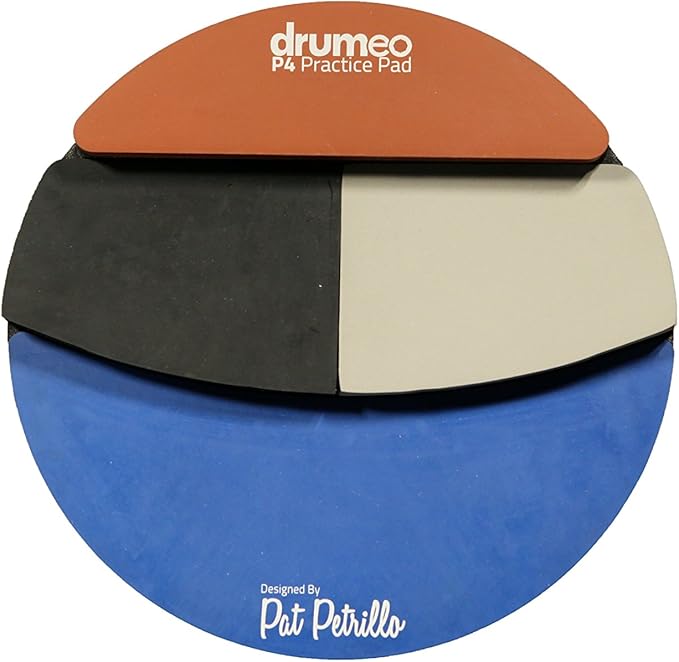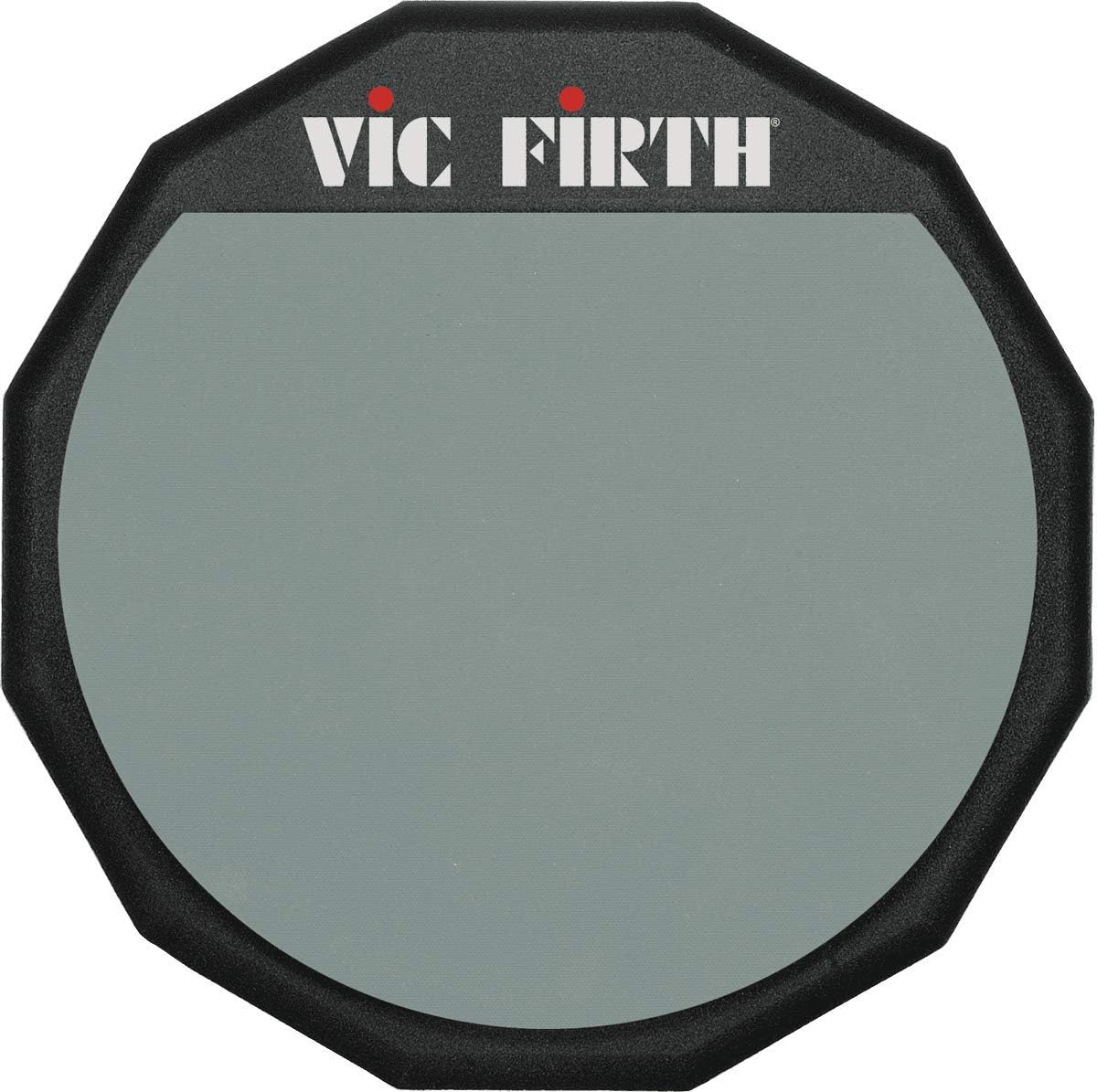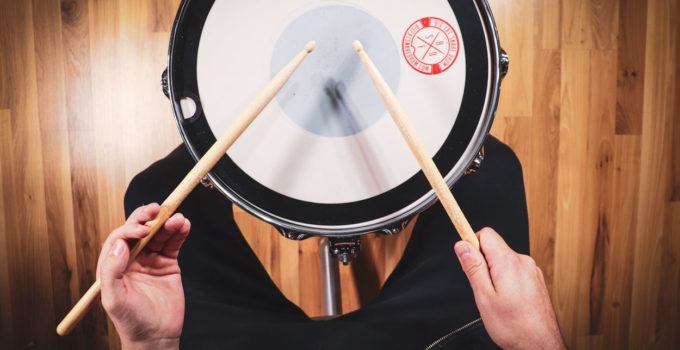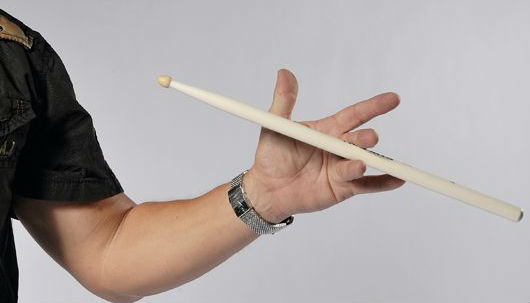Last Updated on July 28, 2021 by Danny
As there is plenty of drum pads for practice on the market, hence it’s not that easy to find the ideal one. This is why we’ve set out on finding the best drum practice pad. The factors we took into consideration are the pad quality, the value for money, the materials, and more.
These drum pads will help you to practice quietly without disturbing people around you and the need for a lot of space.
The 5 Best Drum Practice Pads for Drummers
1. Movement Double Sided Practice Pad All-In-One with Four Different Hitting Surfaces

When you’re looking for the best ways to work on your drumming techniques, a double-sided practice pad is a pretty great solution.
Yes, a multi-surface one might be great as well, although it comes with a few challenges, especially for the beginners who are not yet able to hit each section with precision.
For this purpose, two sides can give enough versatility while keeping things as simple as possible. And this particular practice pad by Movement is a great example of how you can improve your drumming skills with a fairly compact and straightforward piece.
This pad from movement drum co. is a bit larger and is 12 inches in diameter. But although it’s 2-sided, we have 4 different surfaces to practice on.
First, we have a top surface that’s made of very durable silicone rubber, featuring a laminate insert that improves the overall response.
Then, you can play without this insert, getting that realistic drum snare feel.
There’s also a conditioning surface that you can insert, and it provides you with a low rebound and is noticeably more silent.
And then we have the bottom surface of the practice pad that’s significantly softer compared to the top. It’s pretty clear from all these features that we have a fairly versatile snare drum practice pad on our hands.
If you’re into developing your snare playing, this is the pad for you. Plenty of pros, the price is fair, perfect if you’re looking for a portable base that offers the feel of a real, actual snare to practice anywhere.
2. Drumeo P4 Practice Pad Four Different Playing Surfaces

Next up, we’d like to mention Drumeo and their P4 Practice Pad. And this isn’t your average drum pad or a simple playing surface.
As we can already draw a conclusion from the designated name, the P4 Practice Pad comes with four different practicing surfaces. And it’s exactly why, for many players, this comes as the best drumming practice pad.
Yeah, its formation is somewhat unusual, making it look pretty weird at a first glance. However, these four different surfaces make it a pretty innovative and useful one.
The biggest surface, which is in the lower part, features the standard gum rubber, just like on most of the pads you can find today, making it feel like an average snare drum.
Then we have two smaller surfaces right above it, one from hard neoprene-rubber and the other made from a softer material. These two replicate the overall feel of tomb drums.
The harder one, which takes the left side, makes it similar to higher toms, and is louder. Meanwhile, the softer one that’s on the right is quieter and mimics the feel of a floor tom.
Lastly, we have a top surface made of the hardest material. It takes the smallest portion here and its feel is similar to a ride cymbal.
The point of these four surfaces is to give you a quiet drum practice pad that covers as many components as possible in a very compact form.
It’s slightly more expensive compared to any standard pads drum, but it’s definitely worth it.
3. Vic Firth Single Sided Practice Pad

Lastly, we would like to mention the Vic Firth practice pad, a brand that’s unavoidable if we’re talking about the best drum practice pads.
Well-known for their drum sticks, the company has some amazing examples of nice playing surfaces, like their standard single-sided practice pad.
Coming in a few different sizes, you get a fairly simple and yet one of the best practice pads of all time. You’ll see this one in the inventories of both professional players and absolute beginners.
And it’s no wonder since the simplicity and the amazing feel of the pad are all you need for a nice practice session.
What’s really interesting is that the pad is really light. And just imagine how compact and practical the 6-inch version is.
Of course, we also have a full-sized 12-inch one that makes it a great solution for those who prefer a larger surface on a pad, to get more of a snare feel. It’s a single-surface pad, with soft rubber on top.
In addition, the practice pad also comes with a retractable wire brush. Overall, as we already mentioned, this is a fairly simple pad.
And although it features soft rubber rather than some other type of material, the feel is still pretty realistic and you’ll get a very silent performance that won’t bother anyone around you.
It’s not like we would expect anything less than amazing from Vic Firth. There are really a few cons to this high-quality piece of gear.
4. Evans Realfeel 2-Sided Drum Practice Pad, 12 Inch

Talking about the best practice pads for drummers, we can’t help but include Evans and their amazing RealFeel 2-Sided drum practice pad.
Now, as its name suggests, these pads actually provide you with a very realistic feel that you’d get on any standard drum component. This Evans’ pad drum comes in a few different sizes.
And there are also single-side versions, although the 2-sided one is pretty useful. The most common version is a 12-inch one, which provides a pretty big surface that can emulate a snare or a floor tom drum.
Although a standard rubber formation, the surface feels pretty great and the drum sticks bounce the same way they would on a drum skin. However, on its backside, we have harder rubber, which gives out an impression of different types of drum skins.
But aside from the feel and the size, the pad is pretty light and is very useful if you need to practice on the go, whether it’s a vacation or a business trip. It’s pretty common among professional players as well, but it’s also a practice pad that works well for beginners.
Its somewhat “unconventional” shape is just icing on the cake. In addition, it’s not even that expensive, especially considering its quality. This is certainly one of the best drum pads for drum practice, playing it is a breeze. We like the design, too. Let’s continue with our pads for drums.
5. Remo Tunable Practice Pad with Ambassador Coated Drumhead
We can talk about finding the best drum practice pad for days, but it seems that none of them actually mimic some of the important features that a drummer would need.
However, there’s one great example if you need a great beginner drum pad. Made by Remo, this one is a tunable practice pad.
This means that it comes with a regular drum head and its own tuners. These are adjustable and you can use any regular “minus” screwdriver to adjust it. It comes in three sizes and two-color patterns.
We have a 6-inch, an 8-inch, and a 10-inch version. The smallest one has 6 tuning screws, while the other two have 8 of them. A great playing surface overall, it rocks like a proper snare drum.
While it might seem a bit complicated to some, this is exactly what a beginner would need. Is there a better way to learn how to tune a drum component?
In addition, these come with amazing Remo Ambassador Coated heads you can also put them on a regular stand and even create your own custom tunable practice set.
Whether you’re looking for a drum pad for beginners or full-blown professionals, this one by Remo will do the trick. Let’s move on with the drum pads.
How to Choose Drum Practice Pad – Buyer’s Guide
When buying a practice pad, there are a few things that you should look into. Despite being pretty straightforward (in most cases at least), making the right purchase might not be that simple.
The size of the practice pad

Firstly, you need to have the size of a practice pad on your mind. While not something essential in the sense that it will sound better, it’s still important to find the right one for you.
A bigger pad means that you have more room to practice different techniques. On the other hand, a smaller pad will help you learn how to be more precise and hit a specific spot quicker and with ease. So even a 6-inch pad can be a pretty useful tool for drum lessons and practice sessions.
In addition, a smaller practice pad is also way more practical for traveling, or just those who prefer using less room for their practice setups. As for standard sizes, the usual ones are 6, 8, 10, and 12 inches in diameter. Anything above 12 and below 6 wouldn’t really be practical for most drummers. You’ll need to pick one of these sizes based on your pad preferences.
The quietness of the practice pad
In almost all cases, drumming practice pads are pretty silent. Yes, you’ll definitely make some noise, but you won’t be bothering or waking up anyone in the next room, and you most certainly won’t be bothering your neighbors. However, there are different types of surfaces that will not only feel different but that will also be louder or quieter. But no pad will give you any problems with a significantly loud noise.
We mentioned the Drumeo P4 and its four different pad surfaces. Each of these surfaces is made from different materials, each with its unique physical properties. And it’s pretty evident that harder materials on this practice pad tend to get noticeably louder. This is, however, nothing that would be loud enough to bother your home mates or neighbors.
The variety of playing surfaces
We could use this same practice pad as an example since it comes with four different types of surfaces. However, practice pads come with many types of surfaces. While most of them usually focus on softer gum rubber, there are other examples that include materials similar to actual drum heads.
The Remo pad that we mentioned above is such an example, with an actual tunable drum head. Other examples include harder rubber or different inserts that help you add a new feel to the pad by putting them below the top material.
On the other hand, if you want to replicate a feel of a ride cymbal or other harder components, then you’ll need a much harder material. The different playing surfaces may also come in a variety of shapes. While most of them are completely round, there are some examples of octagonal or other similar drumming pads.
While that really won’t impact your performance that much, we’d rather go with a regular circular shape for a pad, preferably the one that has a rim like regular drum components.
Note: Practice pads are very similar in look to electronic drum pad used on electronic kits so never get confused.
FAQ
In the following section, we will cover some of the frequent questions regarding the practice pad, touching on the real drum kit, playing surfaces, serum stick, gum rubber, and playing the best drum practice pads in general. Check it out.
Do I need a drum practice pad?
One of the most often questions for young drummers is whether they need a practice pad at all. While it’s not mandatory, we would certainly say that it can help you immensely in improving your drumming skills, especially if you’re a beginner who can’t have a full real drum set at home.
And to add to this, pretty much all of the experienced and professional drummers have a drum practice pad, even with smaller playing surfaces. It can help you practice when you’re outside your home, or even if you’re going on a vacation and are spending some alone time in a hotel room.
We’d say that it’s an essential tool if you want to become an experienced and skilled drummer since it helps you work on your talents. All you need is a small practice pad and your drum sticks.
What is the quietest drum practice pad?
Well, it’s kind of hard to point out the “quietest” practice drum pad. However, the basic rule always stays the same – the softer the material, the quieter it gets. Overall, practice pads are usually pretty quiet, no matter the material used.
That means that you can get pretty much any practice pad and have a pretty quiet practice session no matter how hard you’re playing with your drum sticks.
The sound will be just loud enough for you to hear the dynamic nuances, but also quiet enough not to disturb people in the room next to yours. A practice pad will certainly never be as loud as a snare drum.
How do Drum Practice Pads work?
Drum practice pads are pretty simple. In most cases, they’re just a surface with a specialized piece of rubber on top of the pad. But despite its simplicity, these components need to be designed in the right way for a drummer to have a good and effective practice session.
In some cases, you’ll find drum practice pads with multiple surface materials. Sometimes, these are two-sided pads, where each side has its own type of surface, giving you a different feel as you’re playing.
While in other cases, we also have a multi-surface formation on just one side, while there are also practice pads where you can add various inserts and get a different feel, including toms and a snare drum vibe.
How do you Clean a Drum Practice Pad?
Knowing that sticks are made of wood (at least in most cases), you’ll have a lot of residue on the practice pad. The cleaning process is pretty simple, although it’s advisable that you do it on a regular basis.
Additionally, you’ll also see a lot of adhesive residues on the pad, which comes as a combination of wood residue, the rubber residue, and your skin. In order to keep your practice as pleasant as possible, you should keep it clean as you can. There aren’t any specific procedures on how you should go about it.
You can simply use anything like a window cleaner or any similar cleaning product for surfaces. You would use these same methods for regular drums as well.
In case you have a drum pad with any removable parts, or a drum pad that has a drum head similar to the one on a drum component, you should take them apart and clean each of its components individually before putting it back together.
An Alternative to Drum Practice Pads: Practice Sets

Of course, having a real drum set with a rocking snare and all comes with its own advantages here. You can’t really get the full practice session going on with just a simple practice pad, can you?
After all, for any drummer of any genre, it’s of absolute importance to practice how to separate each hand and each leg. Even some of the simpler drum grooves will require you to play two different rhythms with one leg and one hand, and a pad can’t offer that.
And although very useful and most certainly something that you should have as a drummer, a simple practice pad won’t get you covered here.
But there’s a solution. If you’re looking for a best practice pad for drummers but also want to practice your full-set chops, there are entire kits for practice.
Yeah, we mentioned the Remo practice pad that can fit some standard drum component stands. However, some manufacturers are creating these practice kits that provide more options.
And that’s not all. Many drummers who live in apartments, or who just don’t feel like making a lot of noise, resort to buying electronic drum sets. And there are actually some of those with components that have a very realistic feel.
In addition, you have a full drum set with a nice module that can be used both for live gigs and studio sessions. And on top of all that, you can even use it as a MIDI controller and use any of the numerous virtual drums that we have on the market these days.
The prices vary, but it’s quite often a significantly more affordable alternative to a full drum set. Sometimes it’s less expensive than just a regular snare.
How to Use Your Practice Pad
The idea of a practice pad is pretty simple. It’s all about sorting out your drum stick techniques and separating your left and right hands. This requires you to learn different techniques, rhythm patterns, and the so-call “rudiments,” which is something that we’ll get to in a minute.
Essentially, you approach the practice pad as you would approach any other individual drumming component. The easiest way to look at it is like playing any snare drum. It’s going to stand right in front of your, preferably on a surface that’s at the same height as a snare drum of a regular drum kit. The practice pad should stand directly in front of you and allow you to hit it with ease.
Rudiments

As we mentioned, practicing rudiments is one of the most essential things to do on a drumming pad. To put it simply, rudiments, or drum rudiments, are actually patterns that can involve both the left and the right hand.
The definition is kind of flexible, but the easiest way to explain it is through a practical example. For instance, one rudiment can be a sequence of eight notes, with your left and right hand alternating in a specific pattern.
There are single stroke patterns drum practice pad, then we have double-stroke patterns where each hand plays two notes, then we have the “diddle”, “paradiddle” which includes single strokes followed by double strokes, and so on.
An example of a paradiddle would be: left, right, left, left, right, left, right, right.
Overall, rudiments are one of the fundamentals of drumming, no matter the genre that you’re playing. These are the patterns that you need to practice in order to have full control and the full separation of your left and right hands.
If you’re learning, let’s say, a guitar or a piano, your fundamentals would be the scales, chords, and arpeggios. In drumming, rudiments are basically an equivalent to that.
Technique

By using a variety of exercises on a drum practice pad, the idea is to improve on the overall stick techniques. This is mostly achieved by learning rudiments and finding ways to implement them in practice.
Additionally, these techniques should not only be applied in playing rhythm patterns, but also finding ways to improve your overall dynamics on the drum practice pad.
After all, being good at this particular aspect is essential for any rhythm section, especially for drummers. This will be one of your main goals when practicing on a drum pad.
And this is exactly why it’s important to have a pad with a realistic feel that you’d get with any drum component. A pad really rocks in this department.
Your timing – Use a metronome!

We could not stress enough how important it is to practice with a metronome when rocking your drum practice pad. A tight rhythm section with a tight drummer is a key component of every good-sounding band or an orchestra.
And especially if we’re talking about modern music. A guitar or a keyboard can be a little off, but a drummer and a bass player always need to stay in the tempo and in the groove. In order to learn this, a metronome will be your best ally.
The first important and the most obvious thing to tackle is your timing. You just need to be on the point, without missing a single beat. Being “tight” means that you always hit on the beat and never “drag” it or rush it. It’s also important to know how to deal with various subdivisions, like quarter notes, eighth notes, sixteenth notes, triplets, quintuplets, and so on.
A metronome is also an important tool if you want to learn how to play faster. Play one exercise at a slow tempo and once you’re confident enough and do everything right, speed up the tempo by the increments of 5 beats per minute. Additionally, it can also help you play slow, which is usually way more difficult than most of the musicians might think.
Additionally, a metronome will help you get a better picture of your overall progress. After a month or two of practice on the pad, you’ll be able to see how much you’ve improved your skills at a given tempo, especially if you’re still in your beginner stages.
Stick tricks

While not essential, learning various stick tricks is always fun. But aside from having just a fun little thing to do, these tricks can improve your coordination and give you more control over your sticks – something that can be of use if you want to become a better drummer.
Probably “the oldest trick in the book” is the so-called “fake spin” where you move the stick between your fingers and it looks as if it’s actually spinning. Another trick is the classic toss, where you throw the stick and catch it, right after it made a full circle in the air.
There are, of course, many others to try out, but we’d rather advise you to focus on the basic techniques and rudiments first. You’ll get the chance to practice tricks when you master the basics.
Summary
As we already said, drum practice pads are a part of every successful drummer’s arsenal. These give you the opportunity to improve your drumming skills, or just keep them at a required level when you don’t have an opportunity to practice on a drum set.
And what’s more, it makes it easier for you to practice in case you just don’t want to make a lot of noise, even if you’re in a hotel room late at night. And it’s especially useful if you’re a beginner that can’t afford to have drums at the moment.
We hope this guide has helped you in finding the ideal pad for your playing. Stay safe and rock the pad, guys!